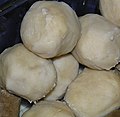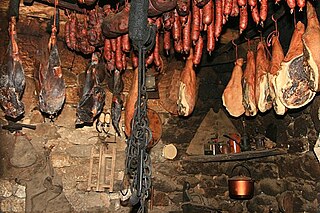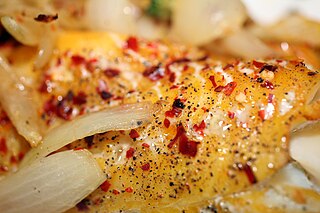
Cod and other cod-like fish have been widely used as food through history. Other cod-like fish come from the same family (Gadidae) that cod belong to, such as haddock, pollock, and whiting.

Cod and other cod-like fish have been widely used as food through history. Other cod-like fish come from the same family (Gadidae) that cod belong to, such as haddock, pollock, and whiting.

Cod is popular as a food with a mild flavour and a dense, flaky white flesh. Young Atlantic cod or haddock prepared in strips for cooking is called scrod. Cod's soft liver can be canned or fermented into cod liver oil, providing an excellent source of vitamin A, vitamin D, vitamin E and omega-3 fatty acids (EPA and DHA).[ citation needed ] Cod flesh is moist and flaky when cooked and is white in colour. In the United Kingdom, Atlantic cod is one of the most common ingredients in fish and chips, along with haddock and plaice. Cod can be easily turned into various other products, such as cod liver oil, omega pills, etc.[ citation needed ]
According to the laws of kashrut, cod is considered kosher because it is a fish with both fins and scales. [1]
This section needs additional citations for verification .(January 2021) |
| Nutritional value per 100 g (3.5 oz) | |
|---|---|
| Energy | 469 kJ (112 kcal) |
0.0 g | |
| Dietary fiber | 0.0 g |
0.93 g | |
24.24 g | |
| Vitamins | Quantity %DV† |
| Thiamine (B1) | 3% 0.040 mg |
| Riboflavin (B2) | 3% 0.045 mg |
| Niacin (B3) | 29% 4.632 mg |
| Pantothenic acid (B5) | 3% 0.150 mg |
| Vitamin B6 | 20% 0.346 mg |
| Folate (B9) | 3% 13 μg |
| Vitamin C | 0% 0.00 mg |
| Minerals | Quantity %DV† |
| Calcium | 3% 42 mg |
| Iron | 8% 1.35 mg |
| Magnesium | 12% 50 mg |
| Phosphorus | 19% 241 mg |
| Potassium | 13% 399 mg |
| Zinc | 4% 0.48 mg |
| †Percentages estimated using US recommendations for adults. [2] | |
Haddock is a very popular food fish, sold fresh, smoked, frozen, dried, and, to a small extent, canned. Haddock, along with cod and plaice, is one of the most popular fish used in British fish and chips.
Fresh haddock has a clean white flesh and can be cooked in the same ways as cod. Freshness of a haddock fillet can be determined by how well it holds together, as a fresh one will be firm; also, fillets should be translucent, while older fillets turn a chalky hue. Young, fresh haddock and cod fillets are often sold as scrod in Boston, Massachusetts; this refers to the size of the fish which have a variety of sizes, i.e. scrod, markets, and cows. Haddock is the predominant fish of choice in Scotland in a fish supper. It is also the main ingredient of Norwegian fishballs (fiskeboller).
Unlike the related cod, haddock does not salt well and is often preserved by drying and smoking.
The smoking of haddock is something that was highly refined in Grimsby. Traditional Grimsby smoked fish (mainly haddock, but sometimes cod) is produced in the traditional smoke houses in Grimsby, which are mostly family-run businesses that have developed their skills over many generations. [3] Grimsby fish market sources its haddock from the North East Atlantic, principally Iceland, Norway and Faroe. These fishing grounds are sustainably managed [4] and have not seen the large scale depreciation in fish stocks seen in EU waters. [5]
One popular form of haddock is Finnan haddie, named for the fishing village of Finnan or Findon in Scotland, where it was originally cold-smoked over peat. Finnan haddie is often served poached in milk for breakfast. [6]
The town of Arbroath on the east coast of Scotland produces the Arbroath Smokie. This is a hot-smoked haddock which requires no further cooking before eating.
Smoked haddock naturally has an off-white color; it is very often dyed yellow, as are other smoked fish. Smoked haddock is the essential ingredient in the Anglo-Indian dish kedgeree.
In 2010, Greenpeace International has added the haddock to its seafood red list. "The Greenpeace International seafood red list is a list of fish that are commonly sold in supermarkets around the world, and which have a very high risk of being sourced from unsustainable fisheries." [7]
Atlantic pollock is largely considered to be a whitefish, although it is a fairly strongly flavored one. Traditionally a popular source of food in some countries, such as Norway, in the United Kingdom it has previously been largely consumed as a cheaper and versatile alternative to cod and haddock. However, in recent years pollock has become more popular due to over-fishing of cod and haddock. It can now be found in most supermarkets as fresh fillets or prepared freezer items. For example, it is used minced in fish fingers or as an ingredient in imitation crab meat.
Because of its slightly gray color, pollock is often prepared, as in Norway, as fried fish balls, or if juvenile sized, breaded with oatmeal and fried, as in Shetland. Year-old fish are traditionally split, salted and dried over a peat hearth in Orkney, where their texture becomes wooden and somewhat phosphorescent. The fish can also be salted and smoked and achieve a salmon-like orange color (although it is not closely related to the salmon), as is the case in Germany where the fish is commonly sold as Seelachs or sea salmon. In Korea, pollock may be repeatedly frozen and melted to create hwangtae, half-dried to create ko-da-ri, or fully dried and eaten as book-o.
In 2009, U.K. supermarket Sainsbury's renamed pollock 'Colin' in a bid to boost ecofriendly sales of the fish as an alternative to cod. [8] The supermarket also suggested some shoppers may be too embarrassed to ask for the species under its proper title, due to its reputation as an inferior fish, and its similarity to a popular English swear word (bollocks). Sainsbury's, which said the new name was derived from the French for cooked pollock (colin), launched the product under the banner "Colin and chips can save British cod".
| Name | Image | Origin | Description |
|---|---|---|---|
| Ackee and saltfish |  | Jamaica | Salt cod sautéed with boiled ackee, onions, Scotch Bonnet peppers (optional), tomatoes, and spices, such as black pepper and pimiento. It can be garnished with crisp bacon and fresh tomatoes, and is usually served as breakfast or dinner alongside breadfruit, hard dough bread, dumplings, fried plantain, or bogreen bananas. Jamaica's national dish. |
| Bacalaíto |  | Puerto Rico and Dominican Republic | Salt cod fritters filled with minced cod fish and garnished with cilantro, tomatoes and onions. A traditional snack typically eaten with an entire meal. Bacalaítos are served at the beach, cuchifritos , and at festivals. They are crisp on the outside and dense and chewy in the inside. |
| Baccalà mantecato |  | Italy | A Venetian appetizer of whipped salt cod. [9] [10] |
| Cabbie claw | Scotland and Orkney | Made with speldings, young fish of the family Gadidae such as cod, haddock or whiting. The name is a derivative of cabillaud, the French name for cod. Other ingredients include parsley, horseradish and mashed potato. The sauce is made with butter, flour, milk, hard-boiled eggs, and nutmeg. Alternate versions outside the traditional version's only difference are usually an addition of more spices. | |
| Bacalhau à Brás |  | Portugal | Made with eggs, onions thinly sliced, potatoes in matchstick-size, salt codfish, soaked, minced garlic clove, extra virgin olive oil, bunch fresh parsley, chopped black Portuguese olives, salt and pepper. [11] |
| Crappit heid | Scotland | (English: stuffed head). Can be traced to the fishing communities of the North, Hebrides and North-Eastern Scotland in the eighteenth century. In a time when money was scarce, the more expensive fillets of fish, such as cod or haddock would be sold to market but the offal and less attractive parts were retained by the fisherfolk for the pot. | |
| Cullen skink |  | Scotland | Thick soup made of smoked haddock, potatoes and onions. An authentic cullen skink will use finnan haddie, but it may be prepared with any other undyed smoked haddock. The soup is often served as a starter at formal Scottish dinners. It has been described as "smokier and more assertive than American chowder and heartier than classical French bisque". [12] |
| Fish and brewis |  | Newfoundland | Consists of cod and hard bread or hard tack . With the abundance of cod around the coasts of Newfoundland and Labrador it became synonymous with many Newfoundland households as a delicacy to be served as a main meal. salt fish is soaked in water overnight to reduce the salt content. The hard bread is broken into bite-size pieces, and is also soaked in water overnight. The next day, the fish and hard bread are boiled separately until tender, and then both are served together. The traditional meal is served with scrunchions , [13] salted pork fat which has been cut into small pieces and fried. Both the rendered fat and the liquid fat are then drizzled over the fish and hard bread. |
| Fish ball |  | Widespread | Usually made from a white fish, such as cod or haddock |
| Fishcake |  | British | Similar to a croquette, consisting of a filleted fish and potato patty sometimes coated in breadcrumbs or batter, and fried. Salted cod is traditionally used as a filling, though since cod stocks have become depleted other varieties of white fish are used, such as haddock or whiting. [14] The fishcake has been seen as a way of using up leftovers that might otherwise be thrown away. In Mrs Beeton's 19th century publication Book of Household Management , her recipe for fishcakes calls for "leftover fish" and "cold potatoes". [15] |
| Fish finger |  | United Kingdom | |
| Fish fry |  | Widespread | |
| Fish pie |  | ||
| Fried fish |  | Widespread | |
| Lutefisk |  | Nordic countries | |
| Pescado frito |  | Spain | |
| Scrod | New England and Atlantic Canada | ||
| Shirako (milt) | Widespread | ||
| Taramosalata |  | Greece | |
| Traditional Grimsby smoked fish |  | Grimsby, England |

Whitefish or white fish is a fisheries term for several species of demersal fish with fins, particularly Atlantic cod, whiting, haddock, hake (Urophycis), and pollock (Pollachius), among others. Whitefish (Coregonidae) is also the name of several species of Atlantic freshwater fish.

Pollock or pollack is the common name used for either of the two species of North Atlantic marine fish in the genus Pollachius. Pollachius pollachius is referred to as pollock in North America, Ireland and the United Kingdom, while Pollachius virens is usually known as saithe or coley in Great Britain and Ireland. Other names for P. pollachius include the Atlantic pollock, European pollock, lieu jaune, and lythe; while P. virens is also known as Boston blue, silver bill, or saithe.

The haddock is a saltwater ray-finned fish from the family Gadidae, the true cods. It is the only species in the monotypic genus Melanogrammus. It is found in the North Atlantic Ocean and associated seas, where it is an important species for fisheries, especially in northern Europe, where it is marketed fresh, frozen and smoked; smoked varieties include the Finnan haddie and the Arbroath smokie. Other smoked version include long boneless, the fileted side of larger haddock smoked in oak chips with the skin left on the fillet.

Bacalhau is the Portuguese word for cod and—in a culinary context—dried and salted cod. Fresh (unsalted) cod is referred to as bacalhau fresco.

Smoked meat is the result of a method of preparing red meat, white meat, and seafood which originated in the Paleolithic Era. Smoking adds flavor, improves the appearance of meat through the Maillard reaction, and when combined with curing it preserves the meat. When meat is cured then cold-smoked, the smoke adds phenols and other chemicals that have an antimicrobial effect on the meat. Hot smoking has less impact on preservation and is primarily used for taste and to slow-cook the meat. Interest in barbecue and smoking is on the rise worldwide.

The Arbroath smokie is a type of smoked haddock, and is a speciality of the town of Arbroath in Angus, Scotland.
Scrod or schrod is a small cod or haddock, and sometimes other whitefish, used as food. It is usually served as a fillet, though formerly it was often split instead.
Norwegian cuisine in its traditional form is based largely on the raw materials readily available in Norway and its mountains, wilderness, and coast. It differs in many respects from continental cuisine through the stronger focus on game and fish. Many of the traditional dishes are the result of using conserved materials, necessary because of the long winters.

Smoked fish is fish that has been cured by smoking. Foods have been smoked by humans throughout history. Originally this was done as a preservative. In more recent times fish is readily preserved by refrigeration and freezing and the smoking of fish is generally done for the unique taste and flavour imparted by the smoking process.

Fresh fish rapidly deteriorates unless some way can be found to preserve it. Drying is a method of food preservation that works by removing water from the food, which inhibits the growth of microorganisms. Open air drying using sun and wind has been practiced since ancient times to preserve food. Water is usually removed by evaporation but, in the case of freeze-drying, food is first frozen and then the water is removed by sublimation. Bacteria, yeasts and molds need the water in the food to grow, and drying effectively prevents them from surviving in the food.

A fishcake is a culinary dish consisting of filleted fish or other seafood minced or ground, mixed with a starchy ingredient, and fried until golden.

Dried and salted cod, sometimes referred to as salt cod or saltfish or salt dolly, is cod which has been preserved by drying after salting. Cod which has been dried without the addition of salt is stockfish. Salt cod was long a major export of the North Atlantic region, and has become an ingredient of many cuisines around the Atlantic and in the Mediterranean.

Scottish cuisine encompasses the cooking styles, traditions and recipes associated with Scotland. It has distinctive attributes and recipes of its own, but also shares much with other British and wider European cuisine as a result of local, regional, and continental influences—both ancient and modern.

Finnan haddie is cold-smoked haddock, representative of a regional method of smoking with green wood and peat in north-east Scotland.

Cured fish is fish which has been cured by subjecting it to fermentation, pickling, smoking, or some combination of these before it is eaten. These food preservation processes can include adding salt, nitrates, nitrite or sugar, can involve smoking and flavoring the fish, and may include cooking it. The earliest form of curing fish was dehydration. Other methods, such as smoking fish or salt-curing also go back for thousands of years. The term "cure" is derived from the Latin curare, meaning to take care of. It was first recorded in reference to fish in 1743.

Fish preservation is the method of increasing the shelf life of fish and other fish products by applying the principles of different branches of science in order to keep the fish, after it has landed, in a condition wholesome and fit for human consumption. Ancient methods of preserving fish included drying, salting, pickling and smoking. All of these techniques are still used today but the more modern techniques of freezing and canning have taken on a large importance.

Traditional Grimsby smoked fish are regionally processed fish food products from the British fishing town of Grimsby, England. Grimsby has long been associated with the sea fishing industry, which once gave the town much of its wealth. At its peak in the 1950s, it was the largest and busiest fishing port in the world.
A fish company is a company which specializes in the processing of fish products. Fish that are processed by a fish company include cod, hake, haddock, tuna, herring, mackerel, salmon and pollock.

Alaska pollock, a species of cod (Gadus) found in the North Pacific ocean, is used as food globally. Compared with common pollock, Alaska pollock is milder in taste, whiter in color, and lower in oil content.